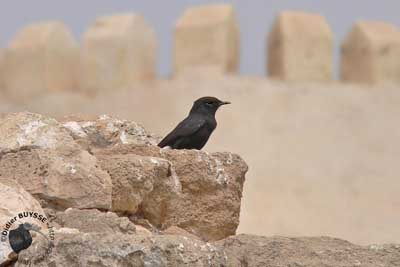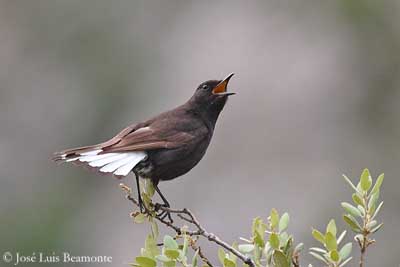
Fr: Traquet rieur
All : Trauerschmätzer
Esp : Collalba Negra
Ital: Monachella nera
Nd: Zwarte Tapuit
Sd: Svart stenskvätta
Photographers:
José Luis Beamonte
Pájaros de España
Didier Buysse
Vision d’Oiseaux
Text by Nicole Bouglouan
Sources:
HANDBOOK OF THE BIRDS OF THE WORLD Vol 10 by Josep del Hoyo-Andrew Elliott-David Christie - Lynx Edicions - ISBN: 8487334725
THE HANDBOOK OF BIRD IDENTIFICATION FOR EUROPE AND THE WESTERN PALEARCTIC by Mark Beaman, Steve Madge - C.Helm - ISBN: 0713639601
ENCYCLOPEDIE DES OISEAUX DE FRANCE ET D’EUROPE – de Peter Hayman et Rob Hume - Flammarion – ISBN : 2082009920
Pájaros de España (JL Beamonte)
XENO-CANTO – Sharing Birds sounds from around the world
BirdLife International (BirdLife International)
Black Wheatear
Oenanthe leucura
Passeriforme Order – Muscicapidae Family
BIOMETRICS:
Length: 18 cm
Wingspan: 26 à 29 cm
Weight: 37-44 g
DESCRIPTION:
Formerly included in the Turdidae family, the Black Wheatear belongs today to the Muscicapidae family.
The Black Wheatear has black and white plumage. Body and wings are glossy black. Rump, undertail feathers at tail base and rectrices are white, except the black tips forming a terminal black band visible on spread tail. The central pair is black on the second half. When the tail is fanned, we can see a conspicuous black reversed T.
In flight, the underwing appears greyish.
Legs, feet and bill are black. The eyes are dark brown.

The female has dark brown back and paler underparts.
The juvenile resembles female but duller.
We can find two subspecies:
O.l. leucura is found in E Portugal, Spain and extreme S France.
O.l. syenitica is found in NW Africa and NW Libya. The male is browner and duller and the female is paler than the nominate race.
VOICE: SOUNDS BY XENO-CANTO
The Black Wheatear utters rapid and repeated alarm call “pii-pii-pii-pii” sometimes interspersed with a typical “tchec”. During the flight displays, it utters a melodious warbler ending in a kind of whistle or rolling notes, repeated for long time.
The female sings sometimes but she gives harsher sounds.
HABITAT:
The Black Wheatear frequents stony and arid bare areas, and it often occurs in mountains. It is found on cliffs, in gorges, ravines, but also in ruins and abandoned houses. It frequents wooded and semi-desert areas.
It is visible from sea level to high mountains, up to 3000 metres of elevation in North Africa.
RANGE:
See above in “subspecies”.
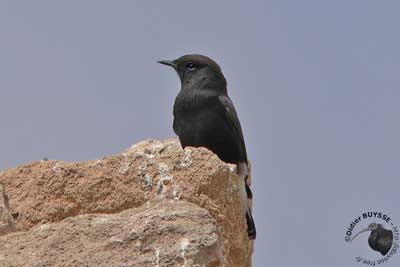
BEHAVIOUR:
The Black Wheatear perches in typical upright stance, often on rock or high place which allows it to watch the ground all around.
This is a shy bird, always fanning its tail, displaying the white colour and the reversed T. This pattern is very suggestive seen from some distance.
During the breeding season, the male perched on rock moves, turns and spreads tail and wings to display the white markings. It also rises in the air while singing, and descends little by little with open wings to the ground, close to the female, and achieves the last phrase of the song.
The breeding period starts as soon as December, but the undulating flights with songs are performed in February. The nest building starts at this time too.
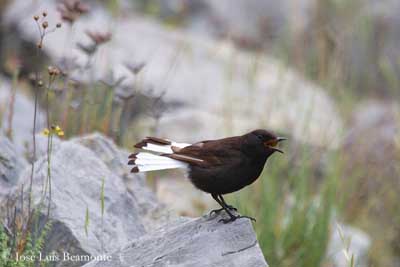
The Black Wheatear is unobtrusive and often seen from far. It takes off to the cover if somebody approaches. We rarely see two pairs close to each other.
The species is sedentary, with only altitudinal movements.
To feed, it walks quickly on the ground, among stones and bushes, and catches numerous insects, such as ants, grasshoppers, butterflies, flies and spiders. It also hunts on the wing.
FLIGHT:
The Black Wheatear makes continuously high flights, and more in breeding season during which these aerial displays are accompanied with pleasant song. This song is often repeated while it fans the tail and spreads the wings, and finally descends to a low perch.
REPRODUCTION:
The nest building starts in February. The Black Wheatear nests in rock crevice or hole, usually at about 1, 60 metre above the ground. Some nests can be found in small caves. The nest is made with dry grasses, stems and twigs, and the interior is lined with feathers, wool and horse hair.
This species is known for adding several small stones under the nest and outside. Almost all the nests have these stones and the number is very variable, from 3-4 up to several hundreds!
One nest has been found with a wall made with 282 stones outside, and 76 for the base of the structure. The male carries them. They can weight from 3 to 10 grams, some of them up to 28 grams that is relatively heavy for a small bird.
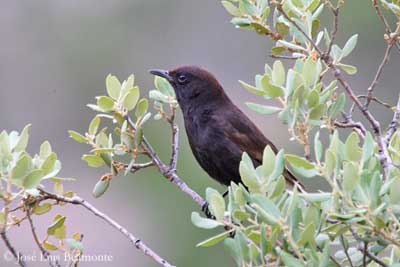
The female lays 4-6 pale blue eggs with some reddish speckles in late March. The incubation lasts about 16-17 days by female.
The chicks are reared by both parents during about two weeks. At hatching, they are partially covered in grey down.
This species can produce several broods per season, usually three.
DIET:
The Black Wheatear is primarily insectivorous, feeding on Coleopterans and Lepidoptera. It also catches Dipterans in flight. It consumes ants, grasshoppers, spiders, small reptiles and berries.
It hunts from perch, rock or low branch, and flies down to the ground to catch its prey. It pursues it on the ground, also digs with the bill to find invertebrates and pecks at the vegetation.
PROTECTION / THREATS / STATUS:
The Black Wheatear has several predators at nest such as snakes, lizards and rats. They are the cause of the low breeding success in numerous regions.
Even fairly common in Spain, the populations decline due to the changes in the habitat and the hard winters involving the extinction of the species in some areas.
However, the Black Wheatear is not threatened at this time.
